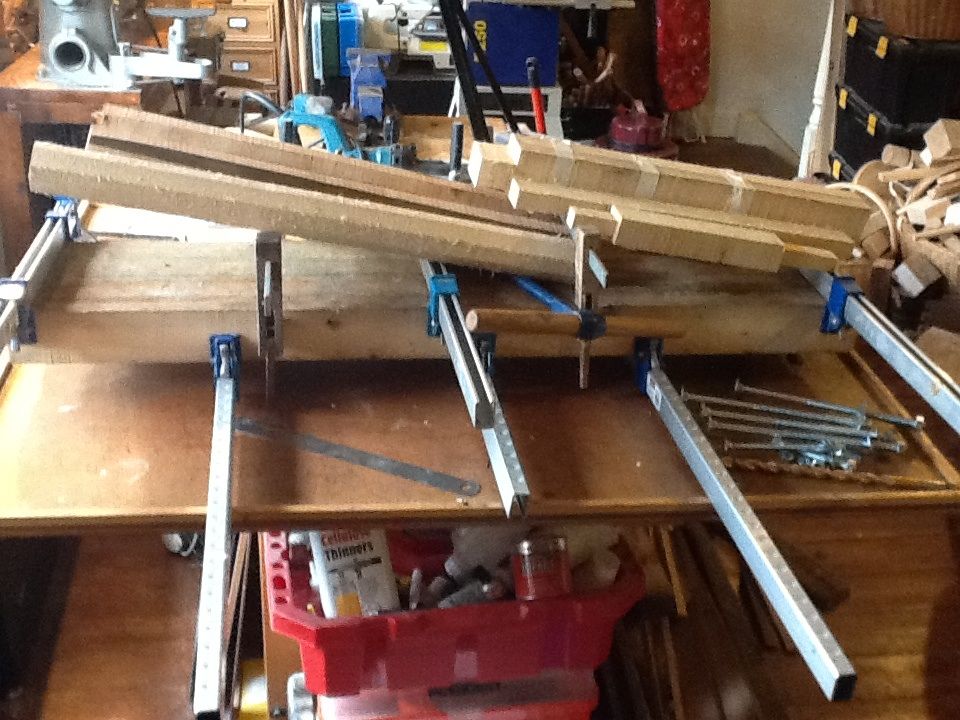On the off chance this will be of interest ill be recording the construction of a basic English style shaving horse, pretty much a per the one on pages 20 and 21 of Ray Tabors "Green woodworking pattern book " 2005 ISBN 0713489146.
Having yet again blown all my money on second hand tools and cream buns and not having access to woodland to process my own I was without the materials to make a shave horse, something that would make my faffing about a lot easier. Less frustrating at the least ! But last week herself brought home a car full of 3 x 9 x 45 " planks, ex a garages inspection pit. Unfortunately on closer inspection the boards were shot, cracked, rotten and chewed up in places so were going to be taken to her scout troop for firewood. Anyroad, a couple of days later I had another look at it and decided to cut out the good pieces and see if there was enough to make a shave horse. Breaking a band saw blade delayed it but as of today I have most of the parts rough cut out.
The main, seat, part is currently clamped together, being made up of four strips glued together back to about the size of one of the original planks, 3 x 9 1/4 x 45". The plan called for 48" but ill have to add a extension if required or just scale down certain parts.
To strengthen this I've bought 4 x half inch by 9 long coach bolts, nuts and washers ( cost about 4 pounds total ) which I will try and fit tomorrow, insetting the heads and nuts so I will be able to plane all the muck and uneven bits off. Realistically ill lose up to a inch each end and a 1/8 th of a inch on the sides, top and bottom, although I may leave the under side rough to get as much thickness as I can. It would have probably been cheaper to buy just threaded rod and nuts and washers to fit, or use reclaimed bolts. I had to get threaded rod for the pivot anyway as no one local had 13 inch bolts.

i still need to sort the 1x 6 x 28" pivot board and the wedge ( 12 long, 4.5 " high, about 4 or 5 wide. ) but here's the parts so far
The rear legs are beech but the rest of the wood is a mystery, I picked the heaviest, most closely grained wood for the horses parts, most of the rest went off to scouts about a hour ago, less some bits that will make a cradle to carry the 1cwt anvil I got last week . I've roughly sawed the legs into hexagon section to go on the lathe .
That's enough for today,
ATB
Tom
Having yet again blown all my money on second hand tools and cream buns and not having access to woodland to process my own I was without the materials to make a shave horse, something that would make my faffing about a lot easier. Less frustrating at the least ! But last week herself brought home a car full of 3 x 9 x 45 " planks, ex a garages inspection pit. Unfortunately on closer inspection the boards were shot, cracked, rotten and chewed up in places so were going to be taken to her scout troop for firewood. Anyroad, a couple of days later I had another look at it and decided to cut out the good pieces and see if there was enough to make a shave horse. Breaking a band saw blade delayed it but as of today I have most of the parts rough cut out.
The main, seat, part is currently clamped together, being made up of four strips glued together back to about the size of one of the original planks, 3 x 9 1/4 x 45". The plan called for 48" but ill have to add a extension if required or just scale down certain parts.
To strengthen this I've bought 4 x half inch by 9 long coach bolts, nuts and washers ( cost about 4 pounds total ) which I will try and fit tomorrow, insetting the heads and nuts so I will be able to plane all the muck and uneven bits off. Realistically ill lose up to a inch each end and a 1/8 th of a inch on the sides, top and bottom, although I may leave the under side rough to get as much thickness as I can. It would have probably been cheaper to buy just threaded rod and nuts and washers to fit, or use reclaimed bolts. I had to get threaded rod for the pivot anyway as no one local had 13 inch bolts.

i still need to sort the 1x 6 x 28" pivot board and the wedge ( 12 long, 4.5 " high, about 4 or 5 wide. ) but here's the parts so far
The rear legs are beech but the rest of the wood is a mystery, I picked the heaviest, most closely grained wood for the horses parts, most of the rest went off to scouts about a hour ago, less some bits that will make a cradle to carry the 1cwt anvil I got last week . I've roughly sawed the legs into hexagon section to go on the lathe .
That's enough for today,
ATB
Tom
Last edited:


 ......
......






